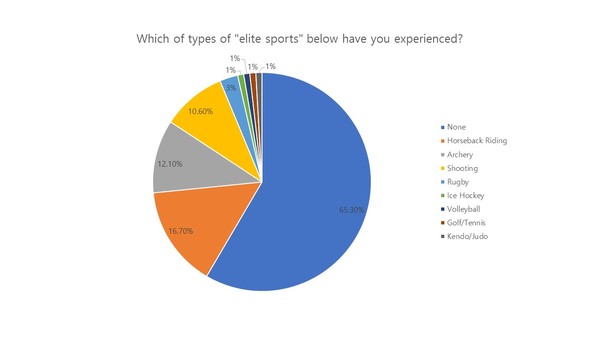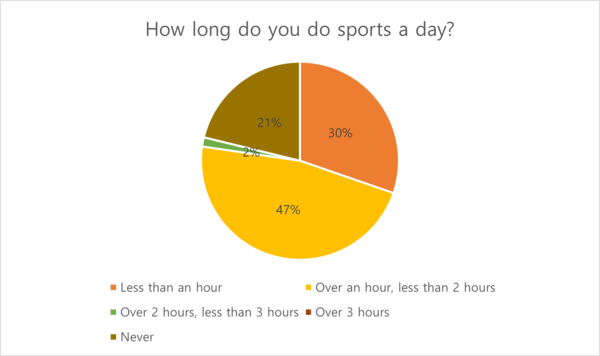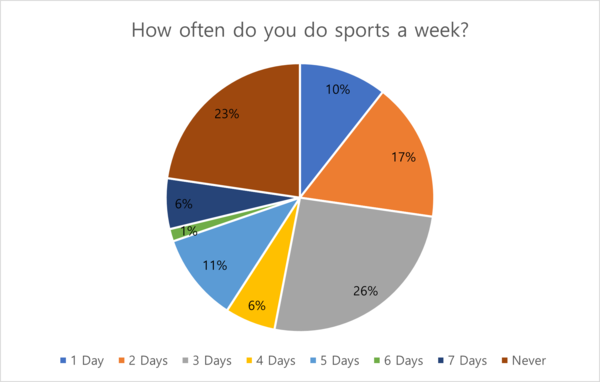
The Tokyo 2020 Olympics have raised many university students’ interest in sports. Students shared their enthusiasm for the games, especially for volleyball and archery. However, although so many athletes who represent South Korea have achieved great deeds, South Korea is hard to say that it is a well-known country to enjoy sports in daily life.
Korean children grow up in a society where most people consider studying the most important work for students; physical education (PE) is not the main part of the Korean education curriculum. Thus, teenagers do not have much experience in sports since the Korean PE curriculum is limited to very common sports such as soccer, basketball, and kickball. On the other hand, foreign countries provide more opportunities for students to try various sports. For example, Japan is a well-known country that teaches diverse sports to teenagers, including handball, tennis, field hockey, and archery. The United States also values physical education and provides many opportunities for students to experience sports since they are young, associating with various sports teams and clubs. The Centers for Disease and Prevention (CDP) of the country has recently introduced the Comprehensive School Activity Program (CSAP) for students’ sports activities after the outbreak of COVID-19. The program is a collaboration model of physical education, physical activity during school, physical activity before and after school, staff involvement, and family and community engagement. Namely, it offers physical education of high quality not only during class, but also in the intervals of a day. Such efforts demonstrate how seriously the United States takes sports as it tries hard to solve the problem of non-face-to-face PE classes.
Unlike people in other countries, Koreans have not been familiar with sports, incurring comparatively low demand to enjoy sports daily. This phenomenon resulted in the existence of a few places where ordinary people can do sports easily. The number of people who spend a lot of time on sports daily is low as well; the rate of Korean people who lack exercise hit 94.2 percent in 2019, which is the highest among 146 countries according to the World Health Organization (WHO). The WHO mentioned insufficient amount of time because of studies, too much time wasted in using smartphones, and not enough sports leisure programs as the main reasons for the result.
To investigate how university students are related to this problem, The UOS Times conducted a survey targeting current university students for five days. 66 students of the University of Seoul (UOS) replied, and by asking them, The UOS Times found out that many university students who grew up in such circumstances tend to feel much harder to drag sports, especially unique ones, into daily life despite their desire.



Through the survey, more than 70 percent of the respondents responded that they exercise at least once a week, and nearly half of them spend over an hour but less than two hours a day for any workout. Even though most students seemed to be using their time to exercise, they answered that they only go to the gym and jog, except for two students who mentioned golf and Taekwondo.
The reasons why students started to work out in daily life varied. One of the biggest reasons for this was to have a healthy life. Students seek a healthy life by losing weight and strengthening their bodies. Students started to exercise because of their parents or friends’ recommendations. There were also other reasons for continuing sports activities in their lives. The improvement in physical strength and endurance enables them to continue working out. Moreover, many of the students said that the best advantage of sports in daily life is “the sense of achievement.” Through positive changes in their body and mind, they build healthy self-consciousness and self-esteem. In fact, there is no conception of success or failure in their daily sports activities, so students can develop themselves steadily and continuously. One way or another, they started to engage in sports activities, and they all felt that it had positive effects on their lives.
The survey conducted by The UOS Times revealed that students in UOS are interested in sports in life and are aware of the advantages. What about the sports that received attention in the 2020 Tokyo Olympics – volleyball, archery, table tennis, fencing, etc.? 65.2 percent of the students answered that they did not get the chance to experience the “Olympic games”. A few respondents who have actually experienced those “uncommon” sports claimed that it was “[their] parents’ suggestion” or “part of the tourism.” This means that there are few ways to experience these sports. In fact, as mentioned above, these sports are not the type of sports that students can experience in the Korean PE curriculum.
The results of the survey demonstrate that the students of UOS demand a chance to experience unique sports. Of the respondents, 90.9 percent said that they would like to experience sports from the Olympics; archery and shooting were the most popular ones. However, it is difficult to enjoy these types of sports in South Korea’s daily life. Many of the Olympic sports are called “elite sports” among Koreans, meaning that only people who are planning to be athletes can easily experience those sports. For “elite athletes,” there is a national training center called Taereung National Training Center, and they are fostered there by training for years in an exclusive environment. On the other hand, ordinary people who are not the “elite athletes, ” but who are eager to try such sports, can hardly find places to experience them. In fact, there is only one place to try archery, one place to try shooting, and nowhere to learn fencing near the UOS campus.
Everyone is aware of the advantages of sports. In Germany, there was a campaign called “Trimm-Aktion, ” which supported various sports clubs in many ways for the welfare of the public. This policy is derived from the idea of creating a prosperous society through sports. At first, sports clubs in Germany were formed by “elite athletes.” However, with the government’s support, such as subsidies for business expenses, tax relief, and free rent, clubs have begun to recruit people who are not in the profession of sports. This type of welfare system is also operated in the U.K. The Five Hours Sports Offer” policy is distinctive, which guarantees opportunities for five hours of sports activities per week through the connection between local sports clubs and schools. Through this policy, children in the U.K. can enjoy various sports that are so-called “elite sports” in South Korea, and the sports clubs can get government’s financial support by cooperating with schools. Those two countries are trying to break the boundary between the “elite sports'' and “sports for all” On the other hand, as mentioned above, college students in South Korea who grew up in the curriculum that barely includes the “elite sports” hardly have a chance to casually experience those sports.
However, South Korea has a similar policy. The Ministry of Culture, Sports, and Tourism has introduced the project called “the active country where every person enjoys sports,” supporting various sports-for-all programs for a neglected class of people and females. Likewise, the country should conduct another revised policy that includes cooperation with other sports clubs or institutions, not only for the minority group but also for students at schools and colleges. In this way, South Korea will be able to break the fine line between “elite sports” and “sports for all” and finally become a society full of healthy and energetic people.
Doing sports as a daily habit is a desirable lifestyle for people, especially college students who spend most of their time sitting down to study. Therefore, The UOS Times discovered a few services for college students to encourage them to participate in sports. Many fitness centers as well as some Pilates centers offer discounts for students. Moreover, there exists a “University Gymnasium and Sports Complex” in the UOS campus. Students can play various indoor and outdoor sports, such as volleyball, indoor tennis, badminton, basketball, etc., with equipment provided by the UOS. There are also a few places where students can experience the “elite games” as well, although they are quite far from the campus. There are various “indoor archery and shooting cafés” located in Seoul. Joining the UOS tennis club called UOSTC or other intercollegiate clubs is another good idea. In this way, students can experience unusual sports and build relationships with other students who have common interests. The UOS Times is looking forward to seeing UOS students freely enjoying any kind of sports they want, more often in their lives.

